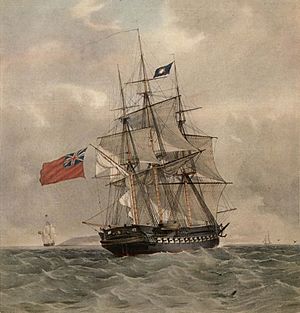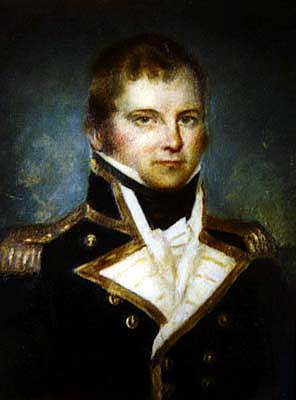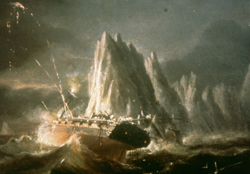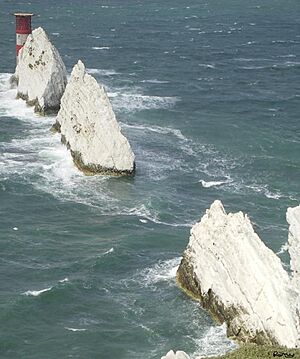HMS Pomone (1805) facts for kids

HMS Pomone, painted by T. G. Dutton after G.F. St.John.
|
|
Quick facts for kids History |
|
|---|---|
| Name | Pomone |
| Ordered | 25 November 1802 |
| Builder | Josiah and Thomas Brindley, Frindsbury |
| Laid down | December 1803 |
| Launched | 17 January 1805 |
| Completed | 29 March 1805 at Chatham Dockyard |
| Commissioned | February 1805 |
| Fate | Wrecked 14 October 1811 |
| General characteristics | |
| Class and type | 38-gun Leda-class frigate |
| Tons burthen | 1,076 tons (bm) |
| Length |
|
| Beam | 39 ft 11 in (12.17 m) |
| Depth of hold | 12 ft 9 in (3.89 m) |
| Sail plan | Full-rigged ship |
| Complement | 284, later 300, then 330 |
| Armament |
|
HMS Pomone was a 38-gun frigate of the Royal Navy. She was part of the Leda-class of ships. Launched in 1805, she played a role in the Napoleonic Wars. Most of her service was in the Mediterranean Sea. Captain Robert Barrie commanded her during this time. Sadly, Pomone was wrecked in 1811 near The Needles, off the Isle of Wight. Today, her wreck is a protected site, looked after by Historic England.
Contents
Life at Sea: Pomone's Adventures
Pomone began her service in February 1805. Her first captain was William Lobb. She worked in the English Channel, helping to protect British waters.
Early Captures (1805-1806)
In 1805, Pomone caught a smuggling ship called Fortune. She also captured two privateers. Privateers were private ships allowed to attack enemy ships during wartime. One of these, the Spanish privateer Golondrina, put up a fight. Pomone had no injuries, but Golondrina had two men wounded. Captain Lobb later burned Golondrina.
In January 1806, Pomone's crew captured another Spanish privateer, the lugger Bengador. This happened off Lisbon. Bengador had taken one prize, a ship called Maid of the Mill. Pomone rescued Maid of the Mill and sent her to Lisbon. The privateer Bengador was then destroyed. Captain Sir Robert Barrie took command of Pomone in May 1806.
Channel Patrols (1807)
In 1807, Pomone continued to patrol the English Channel. She captured or destroyed many French ships. On May 7, boats from Pomone and Hazard bravely entered the harbour of Oyle, Île de Ré. They cut out four French luggers. These luggers were carrying wine and brandy from Bordeaux to Brest. Even though enemy fire sank one, the others were captured.
On June 5, Pomone spotted three armed brigs near the L'Île d'Yeu. Captain Barrie decided to stop them from reaching Les Sables-d'Olonne. As Pomone got closer, they saw the brigs were protecting a convoy of ships. Two brigs ran ashore. Pomone's boats captured another brig that its crew had abandoned.
Barrie then sent his boats into the harbour of St Giles. There, they found many ships that were stuck because there was no wind. Pomone and her boats managed to capture 14 vessels from the harbour. These included brigs, sloops, a dogger, and a chasse-maree. They were full of wheat, flour, and other supplies. The captured ships were sent to Plymouth.
Mediterranean Missions (1808-1809)
In July 1808, Captain Barrie sailed Pomone to the Mediterranean Sea. Almost a year later, on June 13, 1809, Pomone chased and captured the Neapolitan privateer Lucien Charles near Cape Bon. This small ship had three guns and 53 men. Its commander was a high-ranking French officer. Barrie was glad to have caught her, as two valuable ships were nearby.
On October 21, Pomone and Alceste were watching Toulon. They saw the French fleet leaving port. Barrie quickly sailed to tell Admiral Lord Collingwood. He reported that three French battleships, two frigates, and two smaller ships had left a convoy. Pomone later managed to burn some of the convoy's ships. Two French battleships, Lion and Robuste, ran aground and were burned by their own crews.
More Captures (1810)
In March 1810, Pomone was with Seahorse and Cephalus when they captured the ship Bella Nina. Pomone also captured Carducci on April 3. The next day, Seahorse captured Buona Sorte.
On March 31, Pomone captured the French privateer Fortunee. This ship had 10 guns and 53 men. On May 11, Pomone captured another French privateer, the xebec Jupiter. She was armed with eight guns and had a crew of 68 men.
Final Actions (1811)
On January 18, 1811, Pomone captured the French privateer brig Dubourdieu. This ship was from Toulon and had 14 guns and 93 men.
On March 13, Pomone chased a French brig near the Maddalena Archipelago. The brig eventually entered a small cove on Montecristo. When Pomone got close, the brig's crew set her on fire. She blew up about an hour later. This ship was the French warship Etourdie.
On April 30, Pomone arrived at Sagone Bay in Corsica. She was with the frigate Unite and the brig-sloop Scout. They found three French ships in the bay: the 26-gun Giraffe, the 24-gun Nourrice, and an armed merchant ship. These ships were protected by a battery of guns, soldiers, and a tower.
Because there was no wind, the British crews used boats to tow their ships into position. After an hour and a half of firing, the French guns stopped. All three French ships were on fire. The British ships moved away to avoid the explosions. These French ships were carrying timber, and their destruction slowed down shipbuilding in Toulon. The fires also destroyed a Genoese coastal tower and the battery's ammunition. Pomone lost two men and had 19 wounded.
While still in the Mediterranean, Pomone captured a vessel carrying Lucien Bonaparte, his family, and their belongings. Captain Barrie took them all to Malta. Barrie decided that Bonaparte's valuables were private property and did not claim them as prize money.
The Loss of Pomone
On October 14, 1811, Pomone was returning from the Mediterranean. On board was Sir Harford Jones, the British Ambassador to Persia. There were also some special Arab horses, a gift from the Shah of Persia to King George III.
At seven o'clock that evening, the ship's master mistook the light at The Needles for the light at Hurst Castle. Captain Barrie worried they were too far south. He went forward, but it was too late. Someone shouted a warning, but the helmsman could not turn the ship in time.
Pomone hit a hidden rock near Needles point. She went over the rock but lost her rudder and had several holes. Water quickly filled the ship. Without her rudder and full of water, Pomone was hard to control. Waves pushed her onto Needle Point. The crew cut down her masts, but they could not get her off the rocks.
There was no wind, so boats from Tisiphone and pilot boats from Yarmouth quickly came to help. They took the crew off the ship. The gunbrig Escort took Sir Hartford to Portsmouth. Over the next three days, Pomone's cannons, masts, cargo, and valuables were saved. The Shah's horses were carefully moved out through the gun ports. The ship had 55,000 dollars on board, most of which was saved.
A court martial was held on October 25. Captain Barrie and his officers were found not guilty. However, the master was severely criticized for not taking accurate readings and not listening to Barrie's warnings. Because of this wreck, the Admiralty ordered that their ships should not try to pass through the Needle Passage at night. Captain Barrie was later given command of a larger ship, Dragon.
Pomone's Wreck Site
The shipwreck site at The Needles contains parts of two wrecks. One is believed to be HMS Assurance, and the other is the stern (back part) of Pomone. This wreck site was made a protected area on April 4, 1974. Most of the items found here are thought to be from Pomone.
It is also possible that another wreck site in Alum Bay could be the bow (front part) of Pomone. The wreck site was first found by a local resident, Derek Williams.
The Hampshire and Wight Trust for Maritime Archaeology has an Underwater Archaeology Centre. This museum has several exhibits, including one about the wreck of Pomone.
Images for kids






